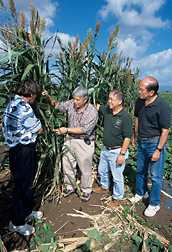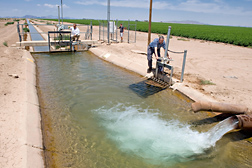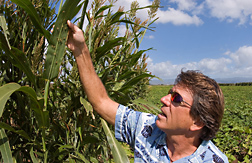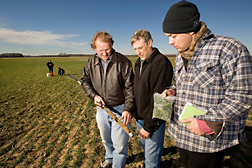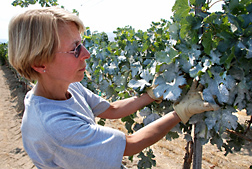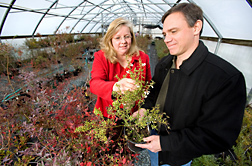A History of Success With State and University Partnerships
The Agricultural Research Service has collaborators in each of the 50 states, many of them at colleges, universities, or state-sponsored organizations. Many, but not all, of these collaborators are land-grant schools––U.S. institutions that receive federal support to teach and conduct research in agriculture and other important subjects.
To its cooperators, ARS offers a national network of award-winning scientists with a history of commodity-related, mission-directed research that has improved U.S. agriculture. In turn, these university and state partners improve ARS’s access to invaluable scientific expertise and experience, skilled personnel, specialized equipment, and local knowledge, resulting in successful collaboration in every state.
Model Training
Sometimes collaboration can enable scientists to broaden the scope of their work. One example is in Maricopa, Arizona, where scientists at the U.S. Arid-Land Agricultural Research Center are investigating improved water-management practices.
Center director Bert Clemmens and his colleagues are developing computer software to automate canal systems, such as those found in large water-distribution networks. Partnering with nearby water districts has allowed them to take new technology beyond the field and test it on a district scale.
Many irrigation districts use Supervisory Control and Data Acquisition (SCADA) systems to monitor and control canal systems remotely. ARS developed new software that works with SCADA software. Known as “SacMan,” for Software for Automated Canal Management, the ARS technology senses changes in the water level within canals and responds by moving canal gates to increase or decrease water flow. SacMan could increase the accuracy of water distribution and help districts provide better service to their clients.
The ARS researchers tested SacMan at the Maricopa-Stanfield Irrigation and Drainage District in central Arizona. The software successfully moved the canal gates in response to changing water levels. ARS is now working with the Central Arizona Irrigation and Drainage District to implement SacMan in the entire 87,000-acre district.
“This partnership provided us with an opportunity to test these various approaches on real canals,” says Clemmens. Without the cooperation, the scientists would have had to test the software on simulation models.
“Models are important for education and training,” he says. “But you have to test software on real canals, because real life has situations that can’t be anticipated by a model.”
The researchers also developed training software to help canal operators master the new technology. This training tool replaces the actual canal with a simulation model of the canal, allowing operators to test their response to situations that might put the real canal at risk.
This technology could result in more efficient water distribution and give land managers greater flexibility in choosing when to irrigate their land.
Fruit Fly, Don’t Bother Me
Complementary expertise has been at the heart of one of ARS’s most successful partnerships, our collaboration with the University of Hawaii Cooperative Extension and the Hawaii Department of Agriculture (HDOA) to control damaging fruit flies in the state.
For the past 100 years, four foreign fruit fly species—Mediterranean fruit fly, melon fly, Oriental fruit fly, and Malaysian fruit fly—have been devastating more than 400 fruits and vegetables in the Hawaiian islands. Susceptible crops include citrus, coffee, eggplant, guava, loquat, mango, melon, papaya, passion fruit, peach, pepper, persimmon, plum, star fruit, tomato, and zucchini. These fruit flies were making it almost impossible for Hawaii’s farmers to raise crops without resorting to almost weekly applications of pesticides. Fruit fly damage cost Hawaii more than $300 million each year in lost markets for locally grown produce.
Previous attempts to control these fruit fly pests had failed. Then in 1999, the ARS Pacific Basin Agricultural Research Center, the state, and the University of Hawaii created the Hawaii Area-Wide Fruit Fly Integrated Pest Management (HAW-FLYPM) program, which has dramatically curtailed fruit fly damage, reduced pesticide use by 90 to 100 percent, and remarkably expanded agricultural potential.
|
|
HAW-FLYPM relies on a comprehensive management package that is economically viable, environmentally sensitive, and sustainable. The technologies include strict field sanitation, protein bait sprays and/or traps, male annihilation with lures and attractants, and population monitoring.
ARS, under the direction of entomologist Roger Vargas, conducted research to develop techniques that worked scientifically and economically. Then the University of Hawaii Cooperative Extension, under the leadership of extension specialist Ronald Mau, designed a communications program and enlisted farmers and home gardeners, made sure they understood the program, and provided hands-on help to implement the research. Feedback from growers and gardeners allowed the program to be continually tweaked to suit individual crops and producers’ circumstances.
From the beginning of the project, HDOA’s involvement was essential to ensuring compliance with regulations, since some of the lures and baits were experimental and had not yet been registered with the U.S. Environmental Protection Agency.
“What really made this program so successful was that partnership was its foundation. A carefully organized interagency team started out talking together, and communication has flowed throughout the program,” Mau says.
The payoff from this level of cooperation is a hefty 32-percent return on an investment of $14 million over 15 years—and that doesn’t count the substantial indirect benefits that don’t have a direct dollar return, such as increased agricultural employment, or reduced environmental exposure to pesticides.
Cleaning the Chesapeake
Planting winter cover crops is an important management practice for reducing agricultural nutrient losses into the Chesapeake Bay and improving ecosystem health. The State of Maryland alone has doubled its budget for its cover crop cost-share program to $18 million in 2008-2009. This will provide for more than 387,000 acres of cover crops with no fall fertilization.
ARS scientists at the Henry A. Wallace Beltsville [Maryland] Agricultural Research Center are partnering with the Maryland Department of Agriculture (MDA) to evaluate winter cover crop performance in the counties east of the bay—the area known as the “Eastern Shore.”
The evaluation uses a unique combination of satellite-sensed and farmer-supplied data. When participating farmers enroll in the MDA cost-share program, they supply information such as field location, planting date, cover crop type, and planting method. Cover crop growth and nutrient uptake can then be estimated for every enrolled field within a region based on analysis of satellite images.
“This powerful new approach has led to improvements in the operation of the MDA program for cover crops,” says Gregory McCarty, with the ARS Hydrology and Remote Sensing Laboratory (HRSL) in Beltsville. “It has also demonstrated how satellite data can be routinely used to implement and monitor important state conservation programs.” The ARS research team works closely with John Rhoderick, chief of MDA’s Resource Conservation Operations.
There are plans to jointly develop an operational cover crop implementation and monitoring tool based on technologies developed through this collaboration. This research effort is part of USDA’s Choptank River Watershed Conservation Effects Assessment Project.
Participating scientists also include Dean Hively, Ali Sadeghi, and Megan Lang, with HRSL, and Laura McConnell, in the ARS Environmental Management and Byproduct Utilization Laboratory, also in Beltsville.
Real Solutions from Virtual Centers
The Northwest Center for Small Fruits Research (NCSFR) and the Northwest Nursery Crops Research Center were both established in the early 1990s, but neither has a single physical location. That’s because these groups are “virtual” centers comprising ARS, university, and industry scientists whose mission is to ensure successful production of small fruits and nursery crops in Washington, Idaho, and Oregon.
|
|
To that end, ARS researchers are bringing their expertise to bear on several projects in close collaboration with their consortium partners.
In one study partially supported by NCSFR, Nahla Bassil, a plant geneticist in the ARS National Clonal Germplasm Repository at Corvallis, Oregon, has worked with geneticist Jeannine Rowland at the ARS Genetic Improvement of Fruits and Vegetables Laboratory in Beltsville, Maryland. The scientists generated several gene sequences for blueberries. They developed genetic markers from those gene sequences and established that these markers could be used to identify not only blueberry varieties, but also cranberry and rhododendron varieties.
A different type of DNA-based marker had previously been developed for cranberries by plant pathologist James Polashock—formerly with Rutgers University, now with the ARS Plant Sciences Institute in Beltsville, Maryland. Bassil and Polashock are collaborating to identify the strengths and weaknesses of each marker system for use in identifying cranberry varieties.
At the Horticultural Crops Research Unit (HCRU) in Corvallis, plant pathologist Jack Pinkerton is investigating alternatives to Nemacur, a nematode-targeting pesticide that has been removed from the market. Like all of the 16 HCRU scientists associated with the centers, he collaborates with colleagues at universities and other ARS locations.
Helping Pinkerton are horticulturist Tom Walters and nematologist Ekaterini Riga, of Washington State University (WSU). The team has tested several alternatives to Nemacur for red raspberry. Pinkerton focuses on how the materials affect the nematode population, whereas Walters evaluates plant performance and fruit yield.
This partnership has been particularly beneficial because of the distance between the ARS laboratories and the test fields. “Taking multiple trips to a field that’s hundreds of miles away from my office isn’t very practical,” Pinkerton says. With WSU colleagues located much closer, he can gather data to analyze without making regular road trips.
In another study, Jungmin Lee, a food technologist at HCRU’s worksite in Parma, Idaho, has begun experiments involving controlled oxidation of polyphenolic compounds isolated from red wine grapes. A key objective is identifying marker compounds to expedite monitoring of polyphenolic oxidation in red wines and to clarify how the process affects color, taste, and other characteristics.
Krista C. Shellie, an HCRU horticulturist at Parma, is concluding a 3-year study with Michael Glenn, director of the ARS Appalachian Fruit Research Station in Kearneysville, West Virginia. The scientists sprayed the foliage of wine grapes with kaolin-particle film to study the effects on fruit quality under deficit irrigation. The studies show that the film’s protective capacity diminishes in relation to the severity of water stress. Colleagues at the University of Idaho processed fruit from these trials into wine, and colleagues at Oregon State University and WSU evaluated the wine’s aroma profile and sensory attributes.
Partnerships like these have been, and continue to be, essential to ARS’s research success.—By Laura McGinnis, Kim Kaplan, Don Comis, and Jan Suszkiw, Agricultural Research Service Information Staff.
This research is part of Human Nutrition (#107), Integrated Agricultural Systems (#207), Water Availability and Watershed Management (#211), Plant Genetic Resources, Genomics, and Genetic Improvement (#301), Plant Diseases (#303), Crop Protection and Quarantine (#304), and Crop Production (#305), seven ARS national programs described on the World Wide Web at www.nps.ars.usda.gov.
To reach the scientists mentioned in this article, contact Laura McGinnis, USDA-ARS Information Staff, 5601 Sunnyside Ave., Beltsville, MD 20705-5129; phone (301) 504-1654, fax (301) 504-1486.
Potatoes: Ultimate Comfort Food Made Even Better
When you’re in the mood to try a potato that’s new and different, chances are good that ARS plant breeders and their university colleagues have bred and developed one you’ll like.
Take Yukon Gem, for instance. A specialty potato with attractive yellow flesh, Yukon Gem is perfect for baking or boiling. It can also be processed into familiar potato products, such as chips and fries.
Yukon Gem is also a jewel when it comes to disease-resistance. It shrugs off attack by worrisome enemies, such as late blight and the common strain of potato virus Y, better than its Yukon Gold parent does.
To develop superior spuds such as this, ARS plant geneticist Richard Novy and plant pathologist Jonathan Whitworth—both at Aberdeen, Idaho—and plant geneticists Charles Brown and Roy Navarre at Prosser, Washington, work with colleagues at Washington State University, Oregon State University, and the University of Idaho in what’s known as the “Northwest (or “Tri-State”) Potato Variety Development Program.” Established in 1985, the program today has more than 30 notable potato varieties to its credit. Colleagues at North Dakota State University also contributed to the development of Yukon Gem.—By Marcia Wood, Agricultural Research Service Information Staff.
"A History of Success With State and University Partnerships" was published in the March 2009 issue of Agricultural Research magazine.







